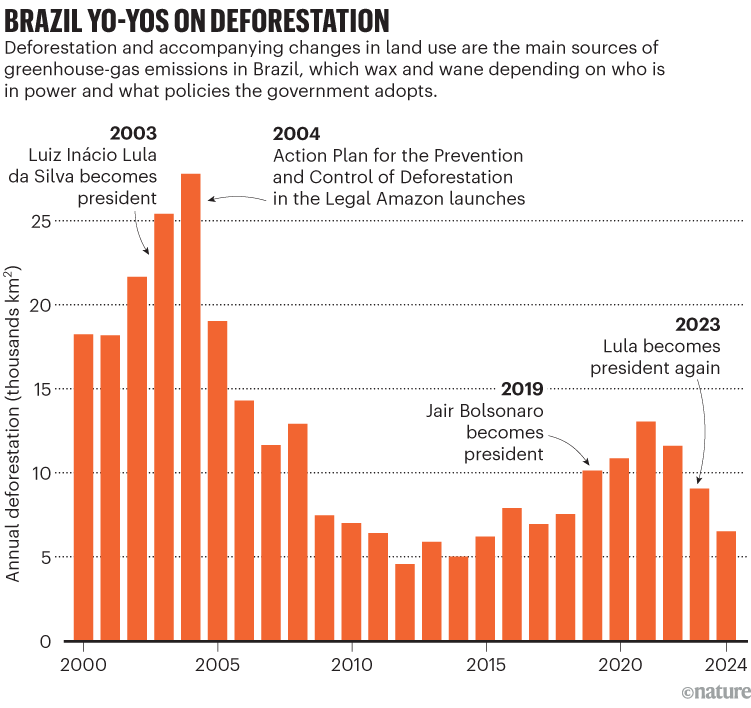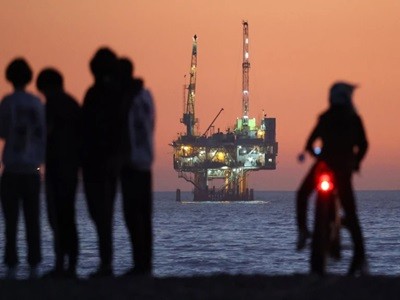When the world’s nations meet for COP30 in Belém, Brazil, on 10 November to lock down new commitments to restrict harmful local weather change, will probably be the primary such convention since US President Donald Trump introduced in January that his nation would, for the second time, exit the landmark Paris local weather deal withy.
Drill, child drill? Trump insurance policies will harm local weather ― however US inexperienced transition is underway
Trump and his administration have championed fossil fuels, known as local weather change “the best con job ever perpetrated on the world” and rolled again federal funding and tax breaks for clear vitality launched beneath former president Joe Biden.
America is the world’s second largest greenhouse-gas emitter, accounting for 11% of worldwide emissions. Though US emissions will proceed to fall beneath Trump, they may improve by as much as 470 million tonnes yearly — greater than thrice the annual complete from the Netherlands — over the subsequent decade in contrast with what they might have been beneath Biden insurance policies, in response to an evaluation led by researchers at Princeton College in New Jersey (J. Jenkins et al. Preprint at Zenodo https://doi.org/qbrm; 2025; see ‘Trump’s local weather legacy’).

Supply: Repeat Mission
The US exit from the Paris accord is not going to change into official till January 2026. Brazil’s President Luiz Inácio Lula da Silva explicitly invited Trump to COP30. However the Trump administration shouldn’t be anticipated to ship any high-level representatives to the assembly, and plenty of say that’s for one of the best. “With out the US, there’s nonetheless an opportunity the world might come collectively in Belém,” says Claudio Angelo, the worldwide coverage coordinator at Observatório do Clima, a coalition of local weather organizations, who is predicated in Brasília.
Whether or not that occurs, and so whether or not humanity bends the emissions curve sufficiently to flee probably the most harmful local weather impacts, relies upon largely on the actions of different large gamers. China is the world’s largest greenhouse-gas emitter, accounting for practically one-third of the worldwide complete — and it’s also the worldwide chief in renewable vitality. India and the European Union come after the US, at 8% and 6 % of emissions, respectively. Brazil is predicted to tackle a much bigger local weather management position as host to COP30 and residential to the Amazon, a significant carbon sink. US states and cities are additionally pursuing their very own clean-energy agendas. COP30, at which nations are anticipated to agree a spherical of more-aggressive local weather targets, provides a glimpse of those actors’ plans.
Will China take the lead on local weather?
Along with being the world’s largest emitter, China has pushed 90% of the expansion in carbon dioxide emissions since 2015, the 12 months the Paris settlement was adopted. However the nation additionally leads the world with regards to adopting clear vitality and producing the gear wanted for the transition to a decarbonized economic system, together with photo voltaic panels, wind generators and electrical autos (see ‘China’s vitality explosion’).

Supply: China Statistical Yearbook, China Electrical energy Council & Natl Power Administration
In September, China’s President Xi Jinping introduced plans to cut back greenhouse-gas emissions by 7–10% from ‘peak ranges’ by 2035. Though some say Beijing’s proposition falls in need of expectations, in addition to quick of what’s wanted to stop catastrophic local weather change, others argue that it’s suitable with the Paris treaty.
Whether or not Washington’s local weather U-turn affected China’s targets is tough to inform. Yao Zhe, a Beijing-based researcher at Greenpeace East Asia, suspects that it may need “demotivated” China to set greater targets, by reducing the bar for what was wanted to look formidable. However a extra urgent issue, she says, is the nation’s slower-than-expected financial development because the COVID-19 pandemic, which has pushed policymakers to prioritize the economic system over environmental and local weather objectives. And if the economic system rebounds, then emissions might too.
That Xi personally introduced China’s newest local weather targets alerts a “very high-level dedication” to tackling local weather change, says Belinda Schäpe, a China analyst on the Centre for Analysis on Power and Clear Air, a assume tank in Helsinki. And it’s actions — not projections — that matter. “Till now, China has a observe file of overperforming on most of its local weather commitments,” says Hu Min, co-founder of the Institute for International Decarbonization Progress, a Beijing-based assume tank.
Trump will weaken local weather motion — the remainder of the US should not comply with swimsuit
China is unlikely to step straight into the management vacuum left by the US as a result of the nations have completely different statuses beneath the Paris settlement, Schäpe says. Developed nations are anticipated to take the lead in chopping emissions, however China is classed as a creating nation beneath the treaty.
One other problem for China with regards to main on local weather is that it’s nonetheless constructing coal-fired energy vegetation. In 2024, the nation was residence to greater than 90% of the coal-power capability that broke floor world wide. The plan is to make use of the brand new services as back-ups for unpredictable renewable energy. However analysts warn that the world may discover it onerous to simply accept a local weather chief that’s nonetheless increasing its coal programme.
China could lead on at COP30 through the use of its affect amongst creating nations to facilitate negotiations with developed ones, says Kim Vender, who researches China’s environmental governance on the Centre for EU-Asia Connectivity in Bochum, Germany. Many predict that China will work with Brazil to safe more cash for creating nations’ efforts to mitigate climate-change impacts. Beijing has endorsed a Brazil-led finance programme geared toward preserving tropical forests, set to be launched in Belém.
With the US federal authorities absent, China may have better affect over international local weather governance at COP30, however the world ought to anticipate management of a distinct flavour, says Yao. “They can not anticipate China to do precisely what the US or different developed nations do.”
Brazil’s net-zero potential
As host of COP30, Brazil’s position is to function a impartial facilitator of negotiations: the federal government says it is going to “lead by instance” on local weather. It has each purpose to wish to: the nation is liable to extreme penalties from local weather change, as demonstrated by devastating floods in 2024 that displaced 500,000 and killed 185 individuals.
One space the place Brazil is nicely positioned to steer in emissions discount is by tackling deforestation. Forests act as sinks that take away carbon from the air; their destruction releases carbon and sometimes paves the best way for emissions-intensive agriculture. In Brazil, which is residence to 60% of the Amazon — the world’s largest tropical rainforest — deforestation and agriculture drive probably the most emissions of any sector.
Deforestation within the Amazon surged beneath former president Jair Bolsonaro (see ‘Brazil yo-yos on deforestation’) and reversing the pattern “shouldn’t be easy”, says Thelma Krug, coordinator of the scientific council for COP30, who is predicated in São José dos Campos.

Supply: Natl Inst. for Area Analysis (INPE), Brazil
In September, Lula introduced a US$1-billion funding within the Tropical Forests Eternally Facility, a fund that may pay nations to guard endangered forests. “It could pay for one thing that has by no means been acknowledged: the hassle creating nations make to maintain elements of their territory intact,” says Krug. At COP30, Lula hopes to safe extra contributions to the fund.
On different commitments to slash emissions, Brazil might discover it more durable to steer by instance. Its newest targets, introduced in November 2024, have been criticized as not formidable sufficient. Sure sectors of the Brazilian authorities nonetheless help tasks that might drive up emissions, reminiscent of a freeway chopping by means of the Amazon and oil drilling on the mouth of the Amazon River.
However the nation nonetheless has nice potential for decisive motion, says Philip Fearnside, an ecologist on the Nationwide Institute for Analysis within the Amazon in Manaus. He thinks that deforestation continues to be comparatively easy to sort out, as a result of it contributes little to Brazil’s economic system. Though deforestation helps sure industries, halting it completely would trigger solely a small dip within the nation’s gross home product, in response to a 2017 evaluation (see go.nature.com/472midv) coordinated by Instituto Escolhas, a sustainability assume tank in São Paulo. And Brazil has hundreds of kilometres of shoreline appropriate for wind energy and best circumstances for photo voltaic farms. Fearnside describes it as “one of many nations that has the simplest choices for truly reaching zero emissions”.

Brazil will make investments US$1 billion in a fund to guard tropical forests such because the Amazon.Credit score: Pablo Porciuncula/AFP/Getty
India motors on local weather objectives
India is charging forward on its local weather commitments beneath the Paris local weather treaty. In June, its authorities introduced that fifty% of put in electrical energy technology capability now comes from non-fossil-fuel sources — a milestone that was reached 5 years forward of the 2030 deadline the nation had set.
The achievement is a part of broader progress in the direction of the nation’s aim beneath the Paris settlement, which the US exit appears unlikely to dent. That’s as a result of India will proceed with its decarbonization agenda for the sake of its personal vitality safety, says Rajani Ranjan Rashmi, a climate-policy researcher at The Power and Sources Institute (TERI) in New Delhi. Self-reliant financial development has been central to Prime Minister Narendra Modi’s governance — and to realize that, India wants renewables reminiscent of wind and photo voltaic.
Will US science survive Trump 2.0?
What’s extra, though India tied decreasing its dependence on fossil fuels to funding from developed nations, it has made progress on that aim despite the fact that a lot of the money has not materialized. “In the end, each massive rising nation has to plan for itself,” says Rashmi.
Alongside its growth in renewables, India is closely reliant on coal and continues to be constructing new capability. The nation, a creating nation beneath the Paris settlement, has argued that it wants the extremely polluting gasoline to energy its economic system and carry the inhabitants out of poverty, and that it doesn’t want to surrender coal within the quick time period, provided that its per capita emissions, and historic emissions, are low in contrast with these of developed nations. However, in 2025, a surge in energy from renewable sources started to exchange coal-powered vitality in India.
The actions of the US federal authorities might nonetheless disrupt India’s decarbonization efforts. India is predicted to submit revised targets at COP30, however whether or not these might be much more formidable than its present ones will rely on “international alerts”, says Rashmi.
The Trump administration’s disruption of worldwide commerce might have an effect on the local weather priorities of creating nations, together with India. “Trump 2.0 is wielding quite a lot of financial weapons to subjugate commerce companions and nations world wide,” says Avantika Goswami, a climate-policy researcher on the Centre for Science and Setting in New Delhi. Such strain can shift the priorities of creating nations away from decarbonizing to, for instance, constructing financial resilience or diversifying their commerce companions, she says.


